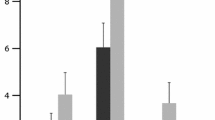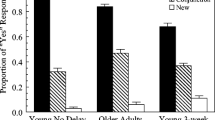Abstract
Event memory and misinformation effects were examined in an adult male gorilla (Gorilla gorilla gorilla). The gorilla witnessed a series of unique events, involving a familiar person engaging in a novel behavior (experiment 1), a novel person engaging in a novel behavior (experiment 2), or the presentation of a novel object (experiment 3). Following a 5- to 10-min retention interval, a tester gave the gorilla three photographs mounted on wooden cards: a photograph depicting the correct person or object and two distractor photographs drawn from the same class. The gorilla responded by returning a photograph. If correct, he was reinforced with food. Across three experiments, the gorilla performed significantly above chance at recognizing the target photograph. In experiment 4, the gorilla showed at-chance performance when the event was followed by misinformation (a class-consistent, but incorrect photograph), but significantly above-chance performance when no misinformation occurred (either correct photograph or no photograph). Although the familiarity can account for these data, they are also consistent with an episodic-memory interpretation.
Similar content being viewed by others
Notes
This was surprising because a familiar target was always present, so the testers could have been above chance by always ruling out the familiar target. Tester B.L.S. used this strategy, but tester T.C. never adopted this particular strategy. Based on his incorrect responses, King did not use this strategy either.
References
Baddeley A (2002) The concept of episodic memory. In: Baddeley A, Conway M, Aggleton J (eds) Episodic memory: new directions in research. Oxford University Press, New York, pp 1–10
Bauer HR, Philip MM (1983) Facial and vocal individual recognition in the common chimpanzee. Psychol Rec 33:161–170
Chambers KL, Zaragoza MS (2001) Intended and unintended effects of explicit warnings on eyewitness suggestibility: evidence from source identification. Mem Cogn 29:1120–1129
Clayton NS, Dickinson A (1998) Episodic-like memory during cache recovery by scrub jays. Nature 395:272–274
Clayton NS, Yu KS, Dickinson A (2001) Scrub jays (Aphelocoma coerulescens) form integrated memories of the multiple features of caching episodes. J Exp Psychol Anim Behav Process 27:17–29
Conway MA, Pleydell-Pearce CW (2000) The construction of autobiographical memories in the self-memory system. Psychol Rev 107:261–288
Gibeault S, MacDonald SE (2000) Spatial memory and foraging competition in captive western lowland gorillas (Gorilla gorilla gorilla). Primates 41:147–160
Harper DN, Garry M (2000) Postevent cues bias recognition performance in pigeons. Anim Learn Behav 28:59–67
Jacoby LL (1991) A process dissociation framework: separating automatic from intentional uses of memory. J Mem Lang 30:513–541
Kelley CM, Jacoby LL (2000) Recollection and familiarity. In: Tulving E, Craik FIM (eds) The Oxford handbook of memory. Oxford University Press, New York, pp 215–228
Loftus EF (1979) Eyewitness testimony. Harvard University Press, Cambridge Mass.
Loftus EF (1993) The reality of repressed memories. Am Psychol 48:518–537
Loftus EF, Hoffman HG (1989) Misinformation and memory: the creation of new memories. J Exp Psychol Gen 118:100–114
MacDonald SE (1994) Gorilla’s (Gorilla gorilla gorilla) spatial memory in a foraging task. J Comp Psychol 108:107–113
Menzel CR (1999) Unprompted recall and reporting of hidden objects by a chimpanzee (Pan trogolodytes) after extended delays. J Comp Psychol 113:426–434
Metcalfe, J (1993) Novelty monitoring, metacognition, and control in a composite holographic associative recall model: interpretations for Korsakoff amnesia. Psychol Rev 100:3–22
Morris RGM (2002) Episodic-like memories in animals: psychological criteria, neural mechanisms and the value of episodic-like tasks to investigate animal models of neurodegenerative disease. In: Baddeley A, Conway M, Aggleton J (eds) Episodic memory: new directions in research. Oxford University Press, New York, pp 181–203
Premack D, Woodruff G (1978) Does the chimpanzee have a theory of mind? Behav Brain Sci 4:515–526
Roberts WA (2002) Are animals stuck in time? Psychol Bull 128:473–489
Roediger HL (1996) Memory illusions. J Mem Lang 35:76–100
Schwartz BL (2003) Do non-human primates have episodic memory? In: Terrace H, Metcalfe J (eds) The missing link in cognition: origins of self-knowing consciousness. Oxford University Press, New York (in press)
Schwartz BL, Evans S (2001) Episodic memory in primates. Am J Primatol 55:71–85
Schwartz BL, Colon MR, Sanchez IC, Rodriguez IA, Evans S (2002) Single-trial learning of “what” and “who” information in a gorilla (Gorilla gorilla gorilla): implications for episodic memory. Anim Cogn 5:85–90
Squire LR (1992) Declarative and non-declarative memory: multiple brain systems supporting learning and memory. J Cogn Neurosci 4:232–243
Suddendorf TS, Corballis MC (1997) Mental time travel and the evolution of the human mind. Gen Soc Gen Psychol Monogr 123:133–167
Swartz KB, Evans S (1994) Social and cognitive factors in chimpanzee and gorilla mirror behavior and self-recognition. In: Parker ST, Mitchell RW, Boccia ML (eds) Self-awareness in animals and humans. developmental perspectives. Cambridge University Press, Cambridge, pp 189–206
Tulving E (1983) Elements of episodic memory. Oxford University Press, New York
Tulving E (1993) What is episodic memory? Curr Dir Psychol 3:67–70
Tulving E (2002) Episodic memory and common sense: how far apart? In: Baddeley A, Conway M, Aggleton J (eds) Episodic memory: new directions in research. Oxford University Press, New York, pp 269–288
Tulving E, Lepage M (2000) Where in the brain is the awareness of one’s past. In: Schacter D, Scarry E (eds) Memory, brain, belief. Harvard University Press, Cambridge, Mass., pp 208–230
Washburn DA, Astur RS (1998) Nonverbal working memory of humans and monkeys: rehearsal in the sketchpad. Mem Cogn 26:277–286
Zentall TR, Clement TS, Bhatt RS, Allen J (2001) Episodic-like memory in pigeons. Psychonomic Bull Rev 8:685–690
Acknowledgements
The research was partially funded by the Grants-in-Aid program from the Florida International University College of Arts and Sciences. Monkey Jungle and the DuMond Conservancy provided logistical support for the project. We are grateful to Monkey Jungle for access to King and for employees’ time. The authors thank Jeannice Blazquez for testing King, and Robert Castillo for constructing stimuli. We thank Sharon Du Mond and Steve Jacques of Monkey Jungle for their encouragement, cooperation, and assistance. We thank Tina Casquarelli, Yuri Mitzkewich, and Julie Kerr of Monkey Jungle for their time and expertise.
Author information
Authors and Affiliations
Corresponding author
Rights and permissions
About this article
Cite this article
Schwartz, B.L., Meissner, C.A., Hoffman, M. et al. Event memory and misinformation effects in a gorilla (Gorilla gorilla gorilla). Anim Cogn 7, 93–100 (2004). https://doi.org/10.1007/s10071-003-0194-7
Received:
Revised:
Accepted:
Published:
Issue Date:
DOI: https://doi.org/10.1007/s10071-003-0194-7




